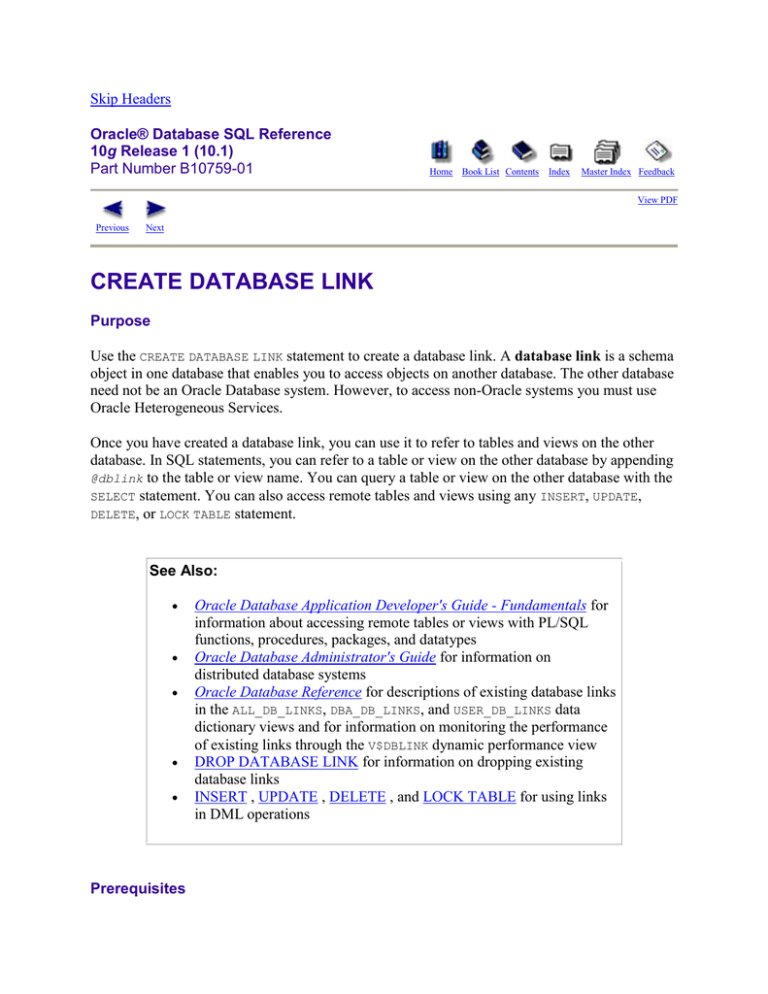
Skip Headers
Oracle® Database SQL Reference
10g Release 1 (10.1)
Part Number B10759-01
Home Book List Contents
Index
Master Index Feedback
View PDF
Previous
Next
CREATE DATABASE LINK
Purpose
Use the CREATE DATABASE LINK statement to create a database link. A database link is a schema
object in one database that enables you to access objects on another database. The other database
need not be an Oracle Database system. However, to access non-Oracle systems you must use
Oracle Heterogeneous Services.
Once you have created a database link, you can use it to refer to tables and views on the other
database. In SQL statements, you can refer to a table or view on the other database by appending
@dblink to the table or view name. You can query a table or view on the other database with the
SELECT statement. You can also access remote tables and views using any INSERT, UPDATE,
DELETE, or LOCK TABLE statement.
See Also:
Prerequisites
Oracle Database Application Developer's Guide - Fundamentals for
information about accessing remote tables or views with PL/SQL
functions, procedures, packages, and datatypes
Oracle Database Administrator's Guide for information on
distributed database systems
Oracle Database Reference for descriptions of existing database links
in the ALL_DB_LINKS, DBA_DB_LINKS, and USER_DB_LINKS data
dictionary views and for information on monitoring the performance
of existing links through the V$DBLINK dynamic performance view
DROP DATABASE LINK for information on dropping existing
database links
INSERT , UPDATE , DELETE , and LOCK TABLE for using links
in DML operations
To create a private database link, you must have the CREATE DATABASE LINK system privilege. To
create a public database link, you must have the CREATE PUBLIC DATABASE LINK system
privilege. Also, you must have the CREATE SESSION system privilege on the remote Oracle
database.
Oracle Net must be installed on both the local and remote Oracle databases.
Syntax
create_database_link::=
Description of the illustration create_database_link.gif
dblink_authentication ::=
Description of the illustration dblink_authentication.gif
Keyword and Parameters
SHARED
Specify SHARED to use a single network connection to create a public database link that can be
shared among multiple users.
See Also:
Oracle Database Administrator's Guide for more information about shared
database links
PUBLIC
Specify PUBLIC to create a public database link available to all users. If you omit this clause, the
database link is private and is available only to you.
See Also:
"Defining a Public Database Link: Example"
dblink
Specify the complete or partial name of the database link. If you specify only the database name,
then Oracle Database implicitly appends the database domain of the local database.
If the value of the GLOBAL_NAMES initialization parameter is TRUE, then the database link must
have the same name as the database to which it connects. If the value of GLOBAL_NAMES is FALSE,
and if you have changed the global name of the database, then you can specify the global name.
The maximum number of database links that can be open in one session or one instance of a Real
Application Clusters configuration depends on the value of the OPEN_LINKS and
OPEN_LINKS_PER_INSTANCE initialization parameters.
Restriction on Creating Database Links
You cannot create a database link in another user's schema, and you cannot qualify dblink with
the name of a schema. Periods are permitted in names of database links, so Oracle Database
interprets the entire name, such as ralph.linktosales, as the name of a database link in your
schema rather than as a database link named linktosales in the schema ralph.)
See Also:
"Referring to Objects in Remote Databases " for guidelines for
naming database links
Oracle Database Reference for information on the GLOBAL_NAMES,
OPEN_LINKS,
and OPEN_LINKS_PER_INSTANCE initialization
parameters
"RENAME GLOBAL_NAME Clause " (an ALTER DATABASE clause)
for information on changing the database global name
CONNECT TO Clause
The CONNECT TO clause lets you enable a connection to the remote database.
CURRENT_USER Clause
Specify CURRENT_USER to create a current user database link. The current user must be a
global user with a valid account on the remote database.
If the database link is used directly, that is, not from within a stored object, then the current user
is the same as the connected user.
When executing a stored object (such as a procedure, view, or trigger) that initiates a database
link, CURRENT_USER is the username that owns the stored object, and not the username that called
the object. For example, if the database link appears inside procedure scott.p (created by
scott), and user jane calls procedure scott.p, the current user is scott.
However, if the stored object is an invoker-rights function, procedure, or package, the invoker's
authorization ID is used to connect as a remote user. For example, if the privileged database link
appears inside procedure scott.p (an invoker-rights procedure created by scott), and user Jane
calls procedure scott.p, then CURRENT_USER is jane and the procedure executes with Jane's
privileges.
See Also:
CREATE FUNCTION for more information on invoker-rights
functions
"Defining a CURRENT_USER Database Link: Example"
user IDENTIFIED BY password
Specify the username and password used to connect to the remote database using a fixed user
database link. If you omit this clause, the database link uses the username and password of each
user who is connected to the database. This is called a connected user database link.
See Also:
"Defining a Fixed-User Database Link: Example"
dblink_authentication
Specify the username and password on the target instance. This clause authenticates the user to
the remote server and is required for security. The specified username and password must be a
valid username and password on the remote instance. The username and password are used only
for authentication. No other operations are performed on behalf of this user.
You must specify this clause when using the SHARED clause.
USING 'connect string'
Specify the service name of a remote database. If you specify only the database name, then
Oracle Database implicitly appends the database domain to the connect string to create a
complete service name. Therefore, if the database domain of the remote database is different
from that of the current database, then you must specify the complete service name.
See Also:
Oracle Database Administrator's Guide for information on specifying remote
databases
Examples
The examples that follow assume two databases, one with the database name local and the other
with the database name remote. The examples use the Oracle Database domain. Your database
domain will be different.
Defining a Public Database Link: Example
The following statement defines a shared public database link named remote that refers to the
database specified by the service name remote:
CREATE PUBLIC DATABASE LINK remote
USING 'remote';
This database link allows user hr on the local database to update a table on the remote database
(assuming hr has appropriate privileges):
UPDATE employees@remote
SET salary=salary*1.1
WHERE last_name = 'Baer';
Defining a Fixed-User Database Link: Example
In the following statement, user hr on the remote database defines a fixed-user database link
named local to the hr schema on the local database:
CREATE DATABASE LINK local
CONNECT TO hr IDENTIFIED BY hr
USING 'local';
Once this database link is created, hr can query tables in the schema hr on the local database in
this manner:
SELECT * FROM employees@local;
User hr can also use DML statements to modify data on the local database:
INSERT INTO employees@local
(employee_id, last_name, email, hire_date, job_id)
VALUES (999, 'Claus', 'sclaus@oracle.com', SYSDATE, 'SH_CLERK');
UPDATE jobs@local SET min_salary = 3000
WHERE job_id = 'SH_CLERK';
DELETE FROM employees@local
WHERE employee_id = 999;
Using this fixed database link, user hr on the remote database can also access tables owned by
other users on the same database. This statement assumes that user hr has SELECT privileges on
the oe.customers table. The statement connects to the user hr on the local database and then
queries the oe.customers table:
SELECT * FROM oe.customers@local;
Defining a CURRENT_USER Database Link: Example
The following statement defines a current-user database link to the remote database, using the
entire service name as the link name:
CREATE DATABASE LINK remote.us.oracle.com
CONNECT TO CURRENT_USER
USING 'remote';
The user who issues this statement must be a global user registered with the LDAP directory
service.
You can create a synonym to hide the fact that a particular table is on the remote database. The
following statement causes all future references to emp_table to access the employees table
owned by hr on the remote database:
CREATE SYNONYM emp_table
FOR oe.employees@remote.us.oracle.com;
Previous
Next
Copyright © 1996, 2003 Oracle Corporation
All Rights Reserved.
Home Book List Contents
Index
Master Index Feedback





